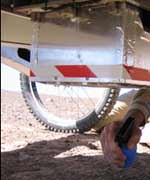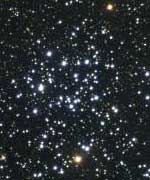
Image credit: CMU
Current Mars expeditions raise the tantalizing possibility that there may be life somewhere on the red planet. But just how will future missions find it? A system being developed by Carnegie Mellon scientists could provide the answer.
At the 36th Lunar and Planetary Science Conference in Houston this week (March 14-18), Carnegie Mellon scientist Alan Waggoner is presenting results of the life detection system’s recent performance in Chile’s Atacama Desert, where it found growing lichens and bacterial colonies. This marks the first time a rover-based automated technology has been used to identify life in this harsh region, which serves as a test bed for technology that could be deployed in future Mars missions.
“Our life detection system worked very well, and something like it ultimately may enable robots to look for life on Mars,” says Waggoner, a member of the “Life in the Atacama” project team and director of the Molecular Biosensor and Imaging Center at Carnegie Mellon’s Mellon College of Science.
The “Life in the Atacama” 2004 field season?from August to mid-October?was the second phase of a three-year program whose goal is to understand how life can be detected by a rover that is being controlled by a remote science team. The project is part of NASA’s Astrobiology Science and Technology Program for Exploring Planets, or ASTEP, which concentrates on pushing the limits of technology in harsh environments.
David Wettergreen, associate research professor in Carnegie Mellon’s Robotics Institute, leads rover development and field investigation. Nathalie Cabrol, a planetary scientist at NASA Ames Research Center and the SETI Institute, leads the science investigation.
Life is barely detectable over most areas of the Atacama, but the rover’s instruments were able to detect lichens and bacterial colonies in two areas: a coastal region with a more humid climate and an interior, very arid region less hospitable to life.
“We saw very clear signals from chlorophyll, DNA and protein. And we were able to visually identify biological materials from a standard image captured by the rover,” says Waggoner.
“Taken together, these four pieces of evidence are strong indicators of life. Now, our findings are being confirmed in the lab. Samples collected in the Atacama were examined, and scientists found that they contained life. The lichens and bacteria in the samples are growing and awaiting analysis.”
Waggoner and his colleagues have designed a life detection system equipped to detect fluorescence signals from sparse life forms, including those that are mere millimeters in size. Their fluorescence imager, which is located underneath the rover, detects signals from chlorophyll-based life, such as cyanobacteria in lichens, and fluorescent signals from a set of dyes designed to light up only when they bind to nucleic acid, protein, lipid or carbohydrate?all molecules of life.
“We don’t know of other remote methods capable both of detecting low levels of micro-organisms and visualizing high levels incorporated as biofilms or colonies,” says Gregory Fisher, project imaging scientist.
“Our fluorescent imager is the first imaging system to work in the daylight while in the shade of the rover. The rover uses solar energy to operate so it needs to travel during daylight hours. Many times, the images we capture may only reveal a faint signal. Any sunlight that leaks in to the camera of a conventional fluorescence imager would obscure the signal,” Waggoner says.
“To avoid this problem, we designed our system to excite dyes with high intensity flashes of light. The camera only opens during those flashes, so we are able to capture a strong fluorescence signal during daytime exploration,” says Shmuel Weinstein, project manager.
During the mission, a remote science team located in Pittsburgh instructed the rover’s operations. A ground team at the site collected samples studied by the rover to bring back for further examination in the lab. On a typical day in the field, the rover followed a path designated the previous day by the remote operations science team. The rover stopped occasionally to perform detailed surface inspection, effectively creating a “macroscopic quilt” of geologic and biological data in selected 10 by 10 centimeter panels. After the rover departed a region, the ground team collected samples examined by the rover.
“Based on the rover findings in the field and our tests in the laboratory, there is not one example of the rover giving a false positive. Every sample we tested had bacteria in it,” says Edwin Minkley, director of the Center for Biotechnology and Environmental Processes in the Department of Biological Sciences.
Minkley is conducting analyses to determine the genetic characteristics of the recovered bacteria to identify the different microbial species present in the samples. He also is testing the bacteria’s sensitivity to ultraviolet (UV) radiation. One hypothesis is that the bacteria may have greater UV resistance because they are exposed to extreme UV radiation in the desert environment. According to Minkley, this characterization also may explain why such a high proportion of the bacteria from the most arid site are pigmented?red, yellow or pink?as they grow in the laboratory.
The first phase of the project began in 2003 when a solar-powered robot named Hyperion, also developed at Carnegie Mellon, was taken to the Atacama as a research test bed. Scientists conducted experiments with Hyperion to determine the optimum design, software and instrumentation for a robot that would be used in more extensive experiments conducted in 2004 and in 2005. Zo?, the rover used in the 2004 field season, is the result of that work. In the final year of the project, plans call for Zo?, equipped with a full array of instruments, to operate autonomously as it travels 50 kilometers over a two-month period.
The science team, led by Cabrol, is made up of geologists and biologists who study both Earth and Mars at institutions including NASA’s Ames Research Center and Johnson Space Center, SETI Institute, Jet Propulsion Laboratory, the University of Tennessee, Carnegie Mellon, Universidad Catolica del Norte (Chile), the University of Arizona, UCLA, the British Antarctic Survey, and the International Research School of Planetary Sciences (Pescara, Italy).
The Life in the Atacama project is funded with a three-year, $3 million grant from NASA to Carnegie Mellon’s Robotics Institute. William “Red” Whittaker is the principal investigator. Waggoner is principal investigator for the companion project in life-detection instruments, which garnered a separate $900,000 grant from NASA.
Original Source: CMU News Release

